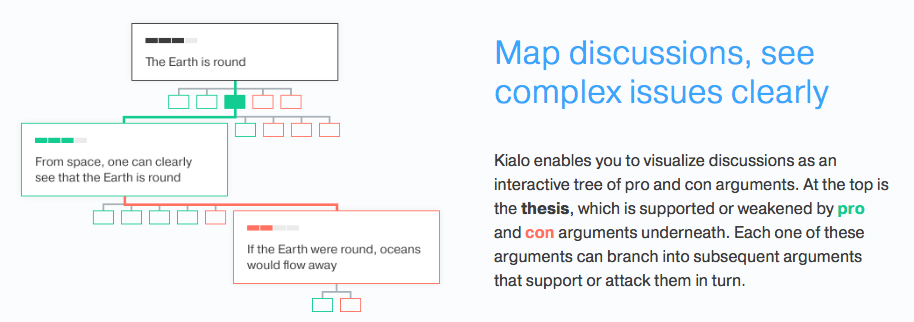Movies reviewed this week: The Maltese Falcon, Quiet Please, Murder, Shadow of a Doubt, and Flesh and Fantasy.
Author: Bryant
I’ll admit it: when you pop up an ad on my Twitter feed telling me about a debate platform powered by reason, the only thing I see is a hazy red cloud of danger surrounding the words “debate” and “reason.” I blame Gamergate and the alt-right for implanting this reflex deep within my soul. Why are you avoiding my attempts to rationally discuss your inferiority?
But I will rise above my bias and check it out… oh god.
Yes, that’s the problem. Not all claims are created equal; demanding that we put equal time into attacking the argument that oceans would flow away if the Earth were round is a bad idea. The quality of a debate is in part determined by the quality of the claims made during that debate.
Kialo tries to mitigate this by allowing users to vote on each statement’s impact, but that means the displayed validity of points is determined by who can turn out their side the best. Obvious flaws are obvious. More subtly, this concept accepts the assumption that all claims are worth engaging with. Consider the (decade-old!) concept of the social denial of service attack.
A long long time ago when I was a desktop support grunt at Sun Microsystems, I encountered the best support feedback mechanism in the world. Every time you closed a ticket, it generated an email to the person who opened the ticket. The email had three faces in it: a smile, a frown, and a neutral. Each face was linked to a URL. Click the appropriate face, register your opinion, go on with your day.
We had a target percentage of smiles. If you ever got a frown, you went down and talked to the person who was unhappy and got the issue resolved; then you told your manager about how you fixed the problem. This process cut down on the number of people who submitted spurious frowns. When your casual expression of dissatisfaction results in a human being asking how she can make it better, you start getting in the habit of saving the frowns for real problems.
The system was very easy to implement. The URLs were something like http://feedback.sun.com/?ticket=XXXXX&happy=1. You don’t need a web app to process that, you just need to run the logs through a bit of perl to aggregate stats. Sun probably was dumping the results into a database cause that’s very simple, but even that wouldn’t take barely any programming. No authentication or anything.
It is, therefore, quite satisfying for me to read this article on HappyOrNot. They’re a Finnish startup that makes a physical version of the smiley face feedback tool. They’re smart, they get the requirement to be frictionless, and they kept the product simple. You just press the button.
True fact: tens of thousands of Londoners happily attended professional wrestling shows during the 1930s. This resurgence in the “sport” was thanks to one Sir Edward Atholl Oakeley, whose autobiography I really gotta read. (In his later years, long after his wrestling career ended, he became the 7th Baronet of Shrewsbury. Wild life story.) He dubbed his wrestling style “All-In,” since it allowed for wrestlers from a variety of traditions. Sir Oakeley always maintained he was promoting real sporting matches, but given that US pro wrestling had already become mostly staged by 1930, it seems pretty likely that All-In wrestling matches were also fixed.
This phase of British professional wrestling history lasted under a decade. By 1940, the quality of the wrestling had degenerated as demand rose. It became more a spectacle, less a sport, and unacceptable in the eyes of civil society. By the time promoters were running mixed gender matches, judges were handing down decrees preventing public shows.
Let’s talk about gaming!
Seattle has a great film scene. It’s on par with San Francisco — no Alamo Drafthouse up here, but we have the Cinerama and SIFF is an excellent film society. I thought I was going to miss Eddie Mueller’s San Francisco based film noir festivals, but it turns out he runs a slightly abbreviated version of the festival up here every year.
It’s that time of year! This’ll be my third go-round at one version or another of this festival. Previous years have coincided with lapsed blogging, alas.
This year’s festival leans heavily into the classics. I am looking forward to watching The Big Sleep and The Maltese Falcon again. I’ve never seen Mildred Pierce or The Blue Dahlia. This should be awesome.
Yep, they continue to be really great after a year of use. Apple hasn’t made progress on the wearable interface yet, alas. They’re still my favorite headphones ever. The unexpected benefit: they’re exactly what I need for using videoconferencing at work. Lightweight, live in my pocket, I don’t have to awkwardly carry them to a conference room when I’m talking to someone remotely. They’re just great.
My friend Pongo wrote an artist’s statement about Ingress. She speaks truth: I have worked with Pongo for over a year now and her ability to infuse the canvas of the game with story is inherently artistic.
I play for different reasons than she does. I’ve been coordinating the actions of teams for 20 years now, at first on AmberMUSH but soon thereafter in my professional career. I’m good at it. Ingress is a difficult but satisfying instance of that task, in a framework that requires me to think on several different layers (people, logistics, tactics, and on occasion grand strategy).
It’s really interesting to consider the game in artistic terms, though.
(“Hey, why did you pick up the blog again?” “Some of my friends are sufficiently artistic to make me feel bad about letting my writing go fallow.”)
 In 1857, a French photographer named René Dagron combined the hot new fad of microphotography and a 50 year old magnifying device called a Stanhope lens to come up with a simple inexpensive way of embedding tiny photographs into a wide range of gewgaws. Stanhope lenses are small enough to embed within rings, watch keys, pocket knives, charms, and so on. Dagron was also an entrepreneur: he ran a mail order business selling the things. Since they were cheap enough to market as souvenirs, they became fairly common fairly quickly.
In 1857, a French photographer named René Dagron combined the hot new fad of microphotography and a 50 year old magnifying device called a Stanhope lens to come up with a simple inexpensive way of embedding tiny photographs into a wide range of gewgaws. Stanhope lenses are small enough to embed within rings, watch keys, pocket knives, charms, and so on. Dagron was also an entrepreneur: he ran a mail order business selling the things. Since they were cheap enough to market as souvenirs, they became fairly common fairly quickly.
The images are remarkably clear and detailed despite their tiny size. One could, hypothetically, put quite a bit of text in one of these. During the Franco-Prussian War of 1870, Dagron refined his microphotography process to generate carrier pigeon messages. This usage didn’t require Stanhope lenses in reality. Who knows what might have happened in a slightly different time stream?
The fad was mostly over by World War I, but there are plenty of the things floating around during the 1930s era of Trail of Cthulhu. If you’re running a Night’s Black Agents game, you’ll be happy to know that Stanhopes still turn up all the time in the wild in 2018. Also fun: it’s not obvious when an object has a Stanhope embedded within it. The photographs are 1/10th of an inch in diameter and a mere quarter of an inch long; modern collectors often miss the presence of a Stanhope. This makes them awesome as unexpected surprises for an investigatory game.
Based on a few hours of Web surfing, I can’t find any evidence that anyone put a Stanhope into a book spine — but someone really should have. This is an easy Bookhounds of London hook. The book itself is something anodyne and unremarkable, but the spine contains images of a horrible crime. Who took them? Why were they preserved in this manner? What’s casting that terrifying shadow in the background?
For a conventional Trail of Cthulhu game, stick the same images in a more traditional Stanhope carrier. Want something more outré? Consider the pocket knife with a small glass aperture at one end. If you look into the glass aperture, what looks back out at you? The Stanhope brooch is the only path this creature has to reach the outer world, and it’s been trapped in there for decades. It will not be grateful to you.
Wait: this Stanhope shows a moving picture. Something strange. It’s the Dreamlands, or Carcosa if you’re into Hastur.
For Night’s Black Agents, a Stanhope would be a great way to introduce a picture of a prominent NPC. Who, of course, looks the same in the picture as he does now. Most photographic evidence of his earlier life was destroyed, but Stanhopes are easy to miss. Or you can go straight espionage, and have one contain microfilm as an information carrier. Also, since we’re talking vampires, I should note that there were plenty of Stanhopes built into crosses. One common cross had seven Stanhopes in it, each one depicting one of the Seven Sorrows of the Virgin Mary. Any vampire game ought to be able to do something useful with that.
Skill-wise, a Trail of Cthulhu character needs Art History or a Evidence Collection spend to notice one of these things. Craft could also work given the right specialty. Bookhounds could use Document Analysis. For Night’s Black Agents, a Notice spend can stand in for Evidence Collection. Art History remains preferable — give those PCs some payoff for all those years spent in museums.
There’s a book on these, which looks really interesting but I’m not sure about giving into temptation. It has pictures, though. Tempting.
Now it can finally be told: up till 2018, I hadn’t successfully read a Le Carré novel. I know this is awful. I love espionage thrillers, I love conspiratorial stuff, and I love great prose. Failing at Le Carré is a major hole in my cultural education. I have no idea what the blocker was. It’s not like I didn’t try often enough.
But the other week I read a review of Our Kind of Traitor and something about the topicality of a Russian vor looking to defect intrigued me, so I picked up yet another Le Carré book and gave it a swing. It was awesome. There’s lots of tension, it moves quickly, and the characterization is great. This is undoubtedly true of everything the man wrote, but this novel hooked me. Maybe because there’s less mystery? I wasn’t sure who was getting manipulated by who till a fairly late stage, but it’s not the kind of subtle obfuscated mystery that we get in the Karla trilogy. Either way I loved it. Bonus points for a cynical conclusion.
Speaking of which, I have now finished Tinker, Tailor, Soldier, Spy and am happily steaming through The Honorable Schoolboy. I see no obstacles from here to the horizon. I will no longer labor with this secret shame.
Movies reviewed this week: Now You See Me 2.
